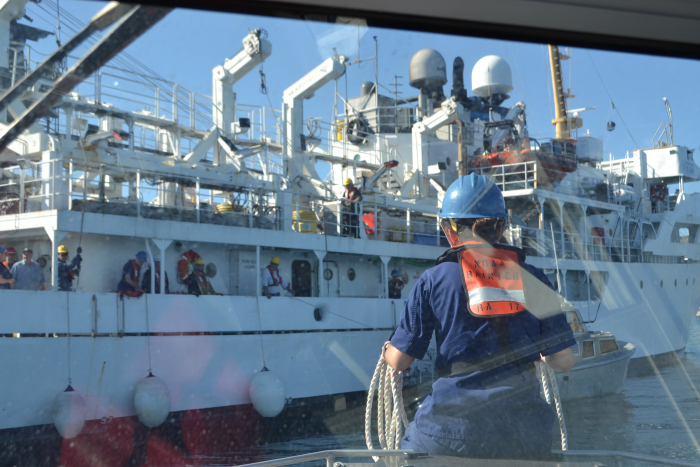By Nick Perugini
In 2017, we celebrated the NOAA Corps Centennial, marking 100 years of valued service to the nation. Today’s NOAA Corps officers play an important role in the Office of Coast Survey. Officers serve as field hydrographers, technical experts, and managers throughout the charting organization. There is a distinct career path for NOAA Corps officers in Coast Survey that provides the opportunity to develop technical expertise in hydrography and at the same time, advance in rank in the NOAA Corps.
From a historical perspective, the Coast and Geodetic Survey Corps—the NOAA Corps predecessor—was created in 1917 primarily to conduct hydrographic and geodetic surveys in the coastal waters of the U.S. As NOAA was formed in 1970, NOAA Corps officers were afforded new opportunities in environmental programs, such as oceanographic, fisheries, weather, and other environmental activities.

For an ensign who graduates from Basic Officer Training Class, a NOAA Corps officer’s first assignment is typically aboard a NOAA ship. New officers assigned to NOAA ships are expected to develop their seamanship skills on their way to becoming a qualified officer of the deck. Aboard hydrographic ships, there is also an expectation that junior officers will develop technical competency in the field of hydrography. This includes developing expertise in positioning equipment, sonar instrumentation, and computer systems that are used aboard ships and launches to acquire and process hydrographic data.

In addition to developing technical expertise, junior officers aboard hydro ships have the opportunity to develop supervisory and management skills. After becoming familiar with the ship’s operation, they can quickly become an officer in charge (OIC) of a survey launch. This entails being in charge of a 30-foot hydrographic launch with a crew of two or more people, whose job it is to collect hydrographic data. The OIC is ultimately responsible for the safety of the launch and its hydrographic production. Many officers enjoy the combination of working outside, battling the elements, managing people, and working with sophisticated data acquisition systems. For many, the work is challenging—but also very rewarding.

After a first tour aboard a hydro ship, many officers will look to other NOAA programs for a shore assignment. However, for those who have caught the “hydro bug,” there are many opportunities to continue a hydrographic career path within Coast Survey. For example, there are OIC and JOIC billets aboard the Bay Hydrographer II working in Chesapeake Bay; officer in charge of a navigation response team; Hydrographic Systems and Technology Programs field support liaison. All of these billets give NOAA Corps officers the ability to increase their technical prowess, sharpen their management and interpersonal skills, and develop a broad understanding of Coast Survey activities.
Officers who follow a career path within Coast Survey typically have an opportunity to become operations officer (Ops) aboard one of NOAA’s four hydrographic ships. As third officer (behind the commanding officer (CO) and executive officer (XO))—typically with a rank of lieutenant—the Ops is responsible for planning the details of day-to-day hydrographic operations. The Ops is required to be a competent hydrographer, as well as a skilled supervisor and manager. The Ops also has the opportunity to sharpen his or her public speaking and communications skills—often being called upon to give presentations to senior officials within the agency.
As a NOAA Corps officer progresses in a Coast Survey career path, there are ample opportunities to gain valuable mid-level and upper management skills. Lieutenant commanders can occupy billets as navigational managers—positions where an officer is expected to communicate Coast Survey’s interests and activities to the public. Navigational managers interface with a wide variety of commercial, recreational, and military maritime interests. Other mid-level management positions are available in Coast Survey’s Navigational Services Division, Hydrographic Survey Division and the Coast Survey Development Lab.

As an officer’s career progresses, CO and XO billets are available for individuals at or nearing the 0-5 (commander) level. Commanding a hydrographic survey ship that performs combined operations is the penultimate experience for a field hydrographer. As senior officers come ashore, there are high level management opportunities available for captains in Coast Survey and throughout NOAA. In Coast Survey or example, NOAA Corps officers serve as division chiefs in the Coast Survey Development Lab, the Hydrographic Surveys Division, and the Navigation Services Division, as well as many senior level positions throughout NOAA.

While there are many challenging positions for NOAA Corps officers within Coast Survey, it is important to note that the organization also welcomes officers with experience outside the charting program. Individuals who have held positions in other parts of NOAA can readily contribute a fresh perspective to Coast Survey’s mission.
NOAA Corps is currently accepting applications for Basic Officer Training Class 132, which will begin in July 2018. The application deadline is January 17, 2018.
UPDATE: NOAA Corps is currently accepting applications for Basic Officer Training Class 133, which will begin in January 2019. The application deadline is June 15, 2018.

